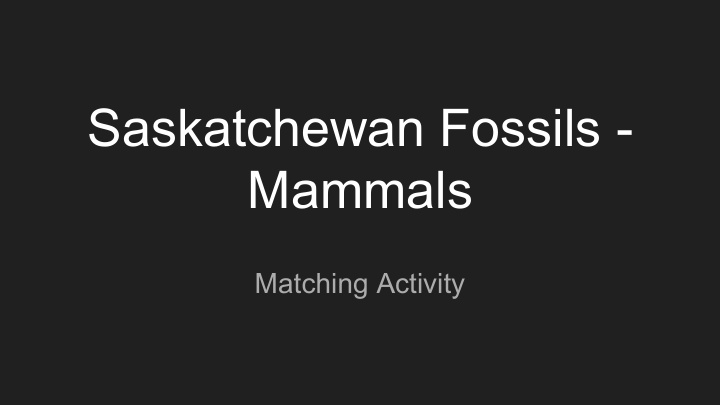



Saskatchewan Fossils - Mammals Matching Activity
Brontothere Molar ● Do you think these molars come from a dinosaur? ● Was this a meat eater or a plant eater? What modern day animal ● does this remind you of?
35 - 38 MYA Fun Facts ● Molars come from mammals. Dinosaurs are not mammals and do not have molars. Dinosaurs went extinct at the end of the Cretaceous Period (65 MYA). ● Brontotheres are plant eating mammals that use their molars to grind up vegetation. ● Brontotheres are related to modern day Rhinos. Unlike Rhinos they ate leaves instead of grass. ● The word “Brontothere” means
Turtle Shell Fragment Questions ● What environment do you think this fossilized turtle lived in? ● How many different turtle species lived in Saskatchewan back then? ● Do you think turtles existed during the time of the dinos?
Late Jurassic to Present Fun Facts ● In Saskatchewan turtles lived during the same time as the dinosaurs. During this time the environment was warm and wet with lots of ponds and streams. ● When the dinosaurs were around, there were 16 species of turtle in Saskatchewan. Today there are only 4 species. ● Turtles survived the dinosaur mass extinction almost unscathed. Only three of the sixteen species went extinct.
Mesohippus Tooth Questions ● How big do you think the earliest horses were? ● How many toes did the earliest horses have? ● Do you think the earliest horses lived on the prairies and ate grass?
30 - 40 MYA Fun Facts ● Saskatchewan’s earliest horses were the size of a cat. They lived in forests and ate leaves. ● Early horses had three toes, wheres as modern horses only have one (hoof). ● As the environment changed from forests to grasslands, horses evolved. It wasn’t just horse size and number of toes that evolved to suit their environment. Their teeth changed to accommodate eating grass instead of leaves, and their legs became longer to allow them to run faster across open areas.
Crocodile Osteoderms Questions ● What part of the body do you think this fossil comes from? ● Why are there no crocodiles in Saskatchewan today? ● How fast are crocodiles?
Fun Facts 92 MYA
Champsosaur Vertebrae Questions ● What part of the body do you think this fossil comes from? ● What environment did this animal live in? ● Is this animal related to dinosaurs, birds and crocodiles?
Fun Facts ● These fossils are apart of the animal’s back bone. ● Champsosaurus were semi aquatic meaning that they lived mostly in water. Their long slender teeth were good for catching fish. ● They are unrelated to crocodiles. They belong to an extinct group of reptiles. However, they did survive the dinosaur mass extinction. Champsosaurus eventually went extinct 40 MYA.
Mammoth Tooth Questions ● What modern animal does a Mammoth look most like? ● What environment did mammoths live in? ● Where do you think Mammoth fossils are found?
Fun Facts ● This ice age animal is related to elephants. Mammoths that lived in Saskatchewan mostly ate grass. ● Mammoth fossils are often found in gravel pits. The gravel was brought and deposited by rivers as the glaciers were melting. These rivers sometimes had animal remains, like mammoth teeth, washed into them.
Recommend
More recommend